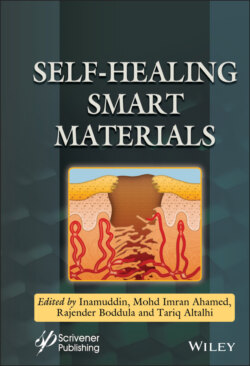Читать книгу Self-Healing Smart Materials - Группа авторов - Страница 17
1.5 Perspectives and Challenges
ОглавлениеThis chapter is intended to show some of the multiple alternatives existing regarding the development of self-healing polymeric coatings, rather than being an exhaustive account of all those reported up to date. It is clear that the research field has advanced substantially since the synthesis of the first self-healing systems was published in the late 1970s and early 1980s. The number of scientific articles has escalated during the last decades, and also the number of patents filled for self-healing protective coatings and films has increased notoriously. However, commercially available products based on self-healing polymers are very scarce, probably due to some weaknesses that need to be addressed in the near future. Possibly the most important shortcoming of self-healing polymers is the need of maintaining the fracture surfaces in close contact to produce a good mending of the pieces. When these materials are used in real applications, this is an important aspect to which look after. Though it can be overcome (at least to a considerable extent) thanks to the localized indirect heating allowed by the presence of nanostructures [141, 142] or to the substrate that holds the two parts in place, it should be kept in mind that most tests on self-healing polymers are carried out in controlled environments, very different from those that the materials face during their usage.
Besides this, the changes that are introduced in the formulations in order to gain self-healing ability are very often deleterious to other properties, resulting in materials with lower Tg values and mechanical properties. Unfortunately, a high Tg value hinders a good healing efficiency in intrinsic self-healing polymers, by freezing the molecular motions that are needed to weld the polymers, whether it is achieved through interdiffusion of polymeric chains or reactions through dynamic covalent bonds. Extrinsic self-healing polymers can maintain their properties after the addition of the micro vessels containing the healing agent, but the properties of the material filling the crack are not the same as those of the original one. The cost associated to many of the raw materials needed to synthesize self-healing coatings, as well as to their processing, often complex and involving multiple steps is another disadvantage. Significant efforts will need to be devoted to find more economic and available materials, and to develop formulations with simpler processing techniques in some cases. Avoiding external catalysts is another aspect to be addressed. External catalysts can be leached from the polymeric matrix over time, preventing the self-healing response to take place and contributing to the environmental pollution which, depending on the nature of the catalyst, can be a severe problem. The inclusion of chemical structures such as cromophores or particles with functional properties—other than the photothermal effect described above—that could be used to sense and detect microcracks within the polymer would be a great leap forward. This has a special relevance considering that the healing efficiency is far higher for mending microcracks than for repairing larger failures (e.g. side-to-side cracks). Hence, if the fracture is detected at an early stage, the repairing will be much better. Some research groups have proposed to use the local increase in the resistance when a crack is generated to both detect and repair the crack through an electric current [150]. This approach still needs from an active role to screen the material for damages, but it is however a very appealing alternative to both detect and repair otherwise undetectable cracks.
Finally, the formulations for self-healing coatings should be able to be processed by some of the methods currently used at industrial level, and not only at a laboratory scale without the need for expensive transformations or new technologies. Beside its use as coatings, some of the systems described herein can find very interesting applications on other areas. For instance, self-healing polymers based on DCBs are also very good candidates to be processed through 3D printing thanks to their moldable macroscopic structure offering them the possibility to flow [81, 103]. This is a challenging aspect that also needs to be addressed, and involves tuning the material rheological properties and the final mechanical and thermal performance. Overall, in view of the most recent advances on self-healing polymeric coatings, it seems that the next years this research field will continue growing steadily, and reach end-user applications in a near future.
